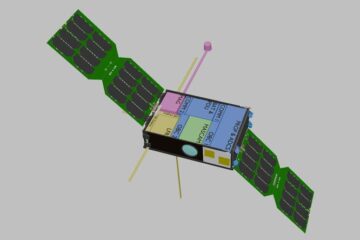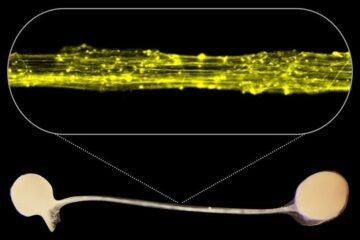Nano-signals get a boost from magnetic spin waves

Groups of nanoscale magnetic oscillators are known to synchronize their individual 10-nanowatt signals to achieve a signal strength equal to the square of the number of devices. Now scientists at the National Institute of Standards and Technology (NIST), Seagate Research Center (Pittsburgh, Pa.) and Hitachi Global Storage Technologies (San Jose, Calif.) have discovered how–the oscillators accomplish this feat by communicating by means of “spin waves,” their magnetic emissions caused by oscillating patterns in the spin of electrons.
The discovery, reported in the Aug. 25 issue of Physical Review Letters, provides a tool for designing “spintronic” devices, which are based on the spin of electrons instead of their charge as in conventional electronics. The NIST oscillators–nanoscale electrical contacts applied to sandwiches of two magnetic films separated by a non-magnetic layer of copper–are hundreds of times smaller than typical commercial microwave generators and potentially could replace much bulkier and expensive components.
The NIST team previously reported “locking” the signals of two oscillators [www.nist.gov/public_affairs/releases/nanooscillators.htm] but were not sure why this occurred. They suspected spin waves, which propagate through solid magnetic materials, or magnetic fields, which propagate through air or a vacuum. So they did an experiment by making two oscillators on the same slab of magnetic multilayer, locking their signals, and then cutting a gap in the solid material between the two devices. The locking stopped.
Lead author Matthew Pufall of NIST compares spin wave locking to dropping two rocks in different sides of a pool of water, so that ripples propagate outward from each spot until they meet and merge. Each oscillator shifts the frequency of its own spin waves to match that of the incoming wave; this “frequency pulling” gets stronger as the frequencies get closer together, until they lock. Each oscillator also adjusts the peaks and troughs of its wave pattern to the incoming wave, until the two sets of waves synchronize.
Media Contact
All latest news from the category: Physics and Astronomy
This area deals with the fundamental laws and building blocks of nature and how they interact, the properties and the behavior of matter, and research into space and time and their structures.
innovations-report provides in-depth reports and articles on subjects such as astrophysics, laser technologies, nuclear, quantum, particle and solid-state physics, nanotechnologies, planetary research and findings (Mars, Venus) and developments related to the Hubble Telescope.
Newest articles

Exploring the Asteroid Apophis With Small Satellites
In five years’ time, a large asteroid will fly very close to Earth – a unique opportunity to study it. Concepts for a national German small satellite mission are being…

First model of the brain’s information highways developed
Our human brain is not only bigger and contains more neurons than the brains of other species, but it is also connected in a special pattern: Thick bundles of neurons…

Why getting in touch with our ‘gerbil brain’ could help machines listen better
Macquarie University researchers have debunked a 75-year-old theory about how humans determine where sounds are coming from, and it could unlock the secret to creating a next generation of more…





















